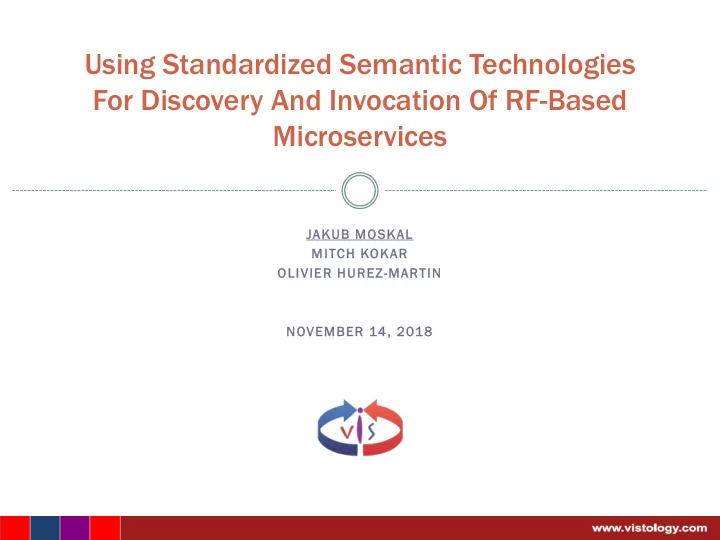

Using Standardized Semantic Technologies For Discovery And Invocation Of RF-Based Microservices JAKUB JA B MOSKAL MITC TCH KO KOKAR OLIVIE IER R HUREZ EZ-MART RTIN NO NOVEMBER 1 14, 4, 20 2018
Context: WALDO Our focus 2
The Challenge Roles/Responsibilities: RF Devices offer services, e.g. spectrum sensing, specific jamming technique, signal detection, using their own API’s Applications request the services offered by the RF device, but are NOT developed against any specific device/service API Middlewa ware matches the requests with available services, but is NOT developed for any specific device or application Middleware designs typically rely on common data models that all participants must be aware of: Typical technologies: Relational databases Data exchange formats: XML, JSON, etc. Well-defined, binary data structures and protocols Semantics is provided only informally: Accompanying documentation Hardcoded in procedural code managing the data As a domain evolves, data models must be updated Because these changes have no explicit semantics, software developed around the model must be updated, which can be difficult, expensive and time-consuming Dedicated, built-in at design-time, application/vendor-specific extensions to these data models work as long as one has full control over all participants Most often, however, they lead to loss of interoperability in the long-term 3
Why Semantic Technologies? In semantic technologies, semantics is exp xplic icit it Ontologies can be dynamically extended to accommodate new terms (even at r runtime! me!) They are processed by gen gener eral al-pu purpo pose inference engines to derive new, implicit facts For instance, to connect the base data model with the extensions As ontologies evolve, the engines remain intact These qualities make ontologies an ideal choice for a future-proof middleware 4
Conceptual Framework – Semantic Web Services 5
Rationale Matching and optimization algorithms operate at a high level of abstraction No need to worry about syntactic variances, e.g. different method names or data structures for semantically equivalent capabilities Inference engine can help determine implicit matches For instance, determine the match between spectrum sensing and energy detection Matching algorithms are domain-independent, hence future-proof with respect to changes in the domain Foundation for decomposition of services enable new possibilities: Optimization, e.g. parallel or redundant execution Opportunistic matching, e.g. detection of 802.11 signals could be decomposed into signal sampling, DSSS detection, OFDM detection and cyclostationary features detection Support for legacy applications and RF devices via automatic inference No strict requirements on the service execution SOAP/WSDL, REST, JSON-RPC 6
W3C OWL-S – Top View W3C OW OWL-S is an upper ontology to describe the semantics of services Three main components: Service Profile Advertising and discovering services Input, Output, Preconditions, Effects (IOPE) Service Model Service composition Choreography and orchestration Service Grounding Binding between the logic-based semantic service profile, the process model and Web Service interface Facilitates execution 7
OWL-S – Service Model 8
Conceptual Plane – Ontology Architecture Similar to OWL-S Moskal J. J., Kokar, M. M., Roman, V., Normoyle, R. B.,&Guseman, R. P. (2017, October). Towards a SpectralSPARQL Standard for Exchanging EMS Knowledge . In Military Communications Conference, MILCOM 2017 IEEE. (Restricted Paper Session) 9
SpectralSPARQL 10
Execution Plane – JSON-RPC REQUEST RESPONSE jsonrpc – protocol version / optional jsonrpc – protocol version /optional method – to be invoked result – data structure representing the output of the method invocation params – data structure to be passed as an input to the method / optional error – passed if there was an error id – of the request id – of the request Examples: Examples: { "jsonrpc": "2.0", Result: "method": "subtract", {"jsonrpc": "2.0", "params": {"subtrahend": 23, "minuend": 42}, "result": 19, "id": 3 "id": 3 } } Error: { "jsonrpc": "2.0", { "jsonrpc": "2.0", "method": "subtract", "error": { "params": [42, 23], "code": -32600, "id": 3 "message": "Invalid Request» } }, "id": null } 11
Semantic Grounding and Lifting The links between the abstract and the concrete Grounding: Convert abstract, ontological terms into concrete executable service invocation Lifting: Convert device-specific data structures to a common ontological representation that can be processed automatically Grounding/Lifting is specific to each device and must be provided during device registration DeVISor uses this information when processing requests/results 12
Semantic Grounding – Example 13
Concept of Operations – Device Registration RF Device DeVISor Register Process Registration Begin Service Provision 14
Concept of Operations – Service Request Application DeVISor RF Device Request Find Service Matches Select Best Ground Service Execute Service Execute API Method Lift Process Response Results 15
Key Benefits Devices: Can have arbitrary API’s to access their services – as long as they are available via JSON-RPC and semantically annotated during registration Register services in terms of a common ontology – do not need to provide additional documentation Can implement their services in virtually any programming language – JSON-RPC is a language-agnostic message-based mechanism Can dynamically define new terms to provide future capabilities Applications: Are developed independently of available devices Do not need any knowledge of the API’s Formulate requests purely in terms of the common ontology Know how to process results because they specify the expected output in ontological terms Can easily combine the results with other facts expressed in the same ontological foundation Middleware (DeVISor): Is agnostic of the domain terms, operates on a high-level plane of service requests and provisions Does not need to be recoded to accommodate new domain terms (e.g. new jamming technique) 16
Minimal Requirements Applications: Use JSON-RPC to submit service requests Express the requests in a common l languag age ( (ontology) Devices: Implement a single JSON-RPC method for registration Express capabilities and map radio functions to the common l langu guage ( ge (ontology gy) as part of the registration Provide access to radio functions via JSON-RPC interface 17
Implementation Asynchronous JSON-RPC via: Netty Framework (Java) Twisted Framework (Python) 18
Demo Setup 19
Thank You! VISTOLOGY, I , INC. HTTP:/ ://WWW.V .VIS ISTOLOGY.C .COM +1 ( (508) 508) 7 788 88-50 5088 88 Mitch Kokar, President Jakub Moskal, CTO mkokar@vistology.com jmoskal@vistology.com 20
Recommend
More recommend